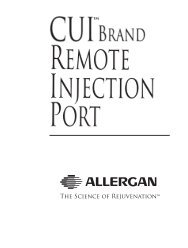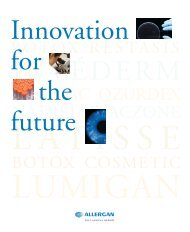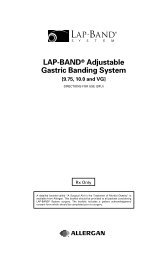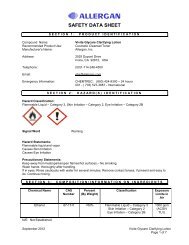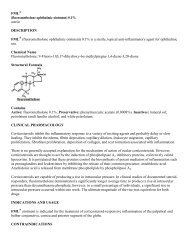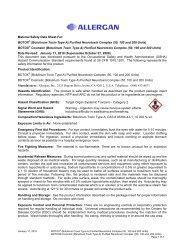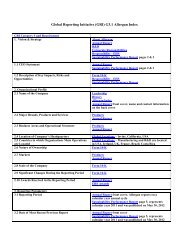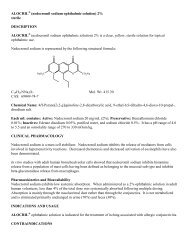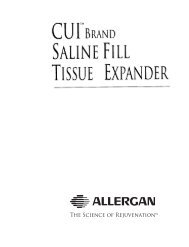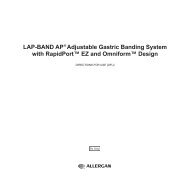NATRELLE® 133 Tissue Expanders with MAGNA-SITE ... - Allergan
NATRELLE® 133 Tissue Expanders with MAGNA-SITE ... - Allergan
NATRELLE® 133 Tissue Expanders with MAGNA-SITE ... - Allergan
Create successful ePaper yourself
Turn your PDF publications into a flip-book with our unique Google optimized e-Paper software.
Directions For UseDirections for UseNATRELLe ® <strong>133</strong><strong>Tissue</strong> <strong>Expanders</strong><strong>with</strong> Magna-Site ®Injection SitesMagna-Finder ® Xact& 21G Needle Infusion Set
CAUTION: U.S. Federal law restricts this device to sale by or on the order of a licensed physician.
TABLE OF CONTENTSSectionPageNatrelle ® <strong>133</strong> <strong>Tissue</strong> <strong>Expanders</strong>............................................................... 2Description............................................................................................... 4Indications................................................................................................ 6Contraindications..................................................................................... 6Information That Should Be Provided to the Patient................................. 7Warnings.................................................................................................. 8Precautions............................................................................................ 10Adverse Reactions................................................................................. 12Breast Implant Surgery Potential Adverse Events................................... 16Instructions for Use................................................................................ 17Surgical Procedure........................................................................... 17Single Use........................................................................................ 17Product Identification........................................................................ 17Sterile Product.................................................................................. 17Product Accessories......................................................................... 18How to Open Product Package........................................................ 18Preliminary Product Examination....................................................... 18.Techniques for Using Natrelle ® <strong>133</strong> <strong>Tissue</strong> <strong>Expanders</strong> ..................... 19Reporting and Return of Explanted Devices........................................... 23Returned Goods Policy.......................................................................... 23Limited Warranty, Limitation of Liability and Disclaimer .......................... 23Product Ordering................................................................................... 23Page 1
STYLE <strong>133</strong> FVSTYLE <strong>133</strong> FVNatrelle ® <strong>133</strong> <strong>Tissue</strong> <strong>Expanders</strong>STYLE <strong>133</strong> LVSTYLE <strong>133</strong> LVNatrelle ® <strong>133</strong> FVShaped <strong>Tissue</strong> ExpanderFull Height, Variable ProjectionSaline-FilledBIOCELL ® Textured<strong>MAGNA</strong>-<strong>SITE</strong> ® Injection SiteSTYLE <strong>133</strong> FXSTYLE <strong>133</strong> FXSTYLESTYLE<strong>133</strong> FV<strong>133</strong> FXSTYLESTYLE<strong>133</strong><strong>133</strong>FXFVNatrelle ® <strong>133</strong> MVShaped <strong>Tissue</strong> ExpanderModerate Height, Variable ProjectionSaline-FilledBIOCELL ® Textured<strong>MAGNA</strong>-<strong>SITE</strong> ® Injection SiteSTYLE <strong>133</strong> MVSTYLE <strong>133</strong> LVSTYLE <strong>133</strong> MVSTYLE <strong>133</strong> LVSTYLE <strong>133</strong> MVSTYLE <strong>133</strong> MVNatrelle ® <strong>133</strong> SVShaped <strong>Tissue</strong> ExpanderShort Height, Variable ProjectionSaline-FilledBIOCELL ® Textured<strong>MAGNA</strong>-<strong>SITE</strong> ® Injection SiteSTYLE <strong>133</strong> MXSTYLE <strong>133</strong> FXSTYLE <strong>133</strong> SVSTYLE <strong>133</strong> MXSTYLE <strong>133</strong> MXSTYLE <strong>133</strong> FXSTYLE <strong>133</strong> SVSTYLE <strong>133</strong> MXNatrelle ® <strong>133</strong> LVShaped <strong>Tissue</strong> ExpanderLow Height, Variable ProjectionSaline-FilledBIOCELL ® Textured<strong>MAGNA</strong>-<strong>SITE</strong> ® Injection SiteSTYLE <strong>133</strong> FVSTYLE <strong>133</strong> MVSTYLE <strong>133</strong> SVSTYLE <strong>133</strong> LVSTYLE <strong>133</strong> SXSTYLE <strong>133</strong> FVSTYLE <strong>133</strong> MVSTYLE <strong>133</strong> SVSTYLE <strong>133</strong> LVSTYLE <strong>133</strong> SXPage 2
STYLE <strong>133</strong> LVSTYLE <strong>133</strong> LVSTYLE <strong>133</strong> FVSTYLE <strong>133</strong> FXSTYLE <strong>133</strong> FVSTYLE <strong>133</strong> FXSTYLE STYLE <strong>133</strong> <strong>133</strong> LV FXSTYLE <strong>133</strong> FX LVNatrelle ® <strong>133</strong> FXShaped <strong>Tissue</strong> ExpanderFull Height, Extra ProjectionSaline-FilledBIOCELL ® Textured<strong>MAGNA</strong>-<strong>SITE</strong> ® Injection SiteSTYLE <strong>133</strong> MVSTYLE <strong>133</strong> MVSTYLE <strong>133</strong> FXSTYLE <strong>133</strong> MVSTYLE <strong>133</strong> FXSTYLE <strong>133</strong> MVNatrelle ® <strong>133</strong> MXShaped <strong>Tissue</strong> ExpanderModerate Height, Extra ProjectionSaline-FilledBIOCELL ® Textured<strong>MAGNA</strong>-<strong>SITE</strong> ® Injection SiteSTYLE <strong>133</strong> MXSTYLE <strong>133</strong> MXSTYLE <strong>133</strong> MVSTYLE <strong>133</strong> MXSTYLE <strong>133</strong> SVSTYLE <strong>133</strong> MVSTYLE <strong>133</strong> MXSTYLE <strong>133</strong> SVNatrelle ® <strong>133</strong> SXShaped <strong>Tissue</strong> ExpanderShort Height, Extra ProjectionSaline-FilledBIOCELL ® Textured<strong>MAGNA</strong>-<strong>SITE</strong> ® Injection SiteSTYLE <strong>133</strong> SVSTYLE <strong>133</strong> SVSTYLE <strong>133</strong> MXSTYLE <strong>133</strong> MXSTYLE <strong>133</strong> SXSTYLE <strong>133</strong> SXPage 3STYLE <strong>133</strong> SVSTYLE <strong>133</strong> SXSTYLE <strong>133</strong> SVSTYLE <strong>133</strong> SX
DescriptionNatrelle ® <strong>133</strong> <strong>Tissue</strong> <strong>Expanders</strong> are intended for temporary subcutaneousimplantation and require periodic, incremental inflation <strong>with</strong> sterile saline forinjection until the desired amount of tissue is developed.Natrelle ® <strong>133</strong> <strong>Tissue</strong> <strong>Expanders</strong> are constructed from silicone elastomer and consistof an expansion envelope <strong>with</strong> a BIOCELL ® textured surface, and a <strong>MAGNA</strong>-<strong>SITE</strong> ®integrated injection site. The expanders are available in a wide range of styles andsizes to meet diverse surgical needs. Specific styles are described above, underNatrelle ® <strong>133</strong> <strong>Tissue</strong> <strong>Expanders</strong>.All Natrelle ® <strong>133</strong> <strong>Tissue</strong> <strong>Expanders</strong> <strong>with</strong> the <strong>MAGNA</strong>-<strong>SITE</strong> ® integrated injection portare supplied <strong>with</strong> a sterile <strong>MAGNA</strong>-FINDER ® Xact external locating device and a21G Needle Infusion Set. In addition, <strong>Tissue</strong> Expander Fill Kits, BIOCELL ® DeliveryAssistance Sleeves and other product accessories are available separately.For more information on specific styles and accessories, please contact your<strong>Allergan</strong> Breast Aesthetics Surgical Sales Representative, or the Customer CareDepartment at 1.800.766.0171.<strong>Tissue</strong> Expander Shapes• Natrelle ® <strong>133</strong> <strong>Tissue</strong> <strong>Expanders</strong> are designed as part of a system forbreast reconstruction to create a pocket for placement of a Natrelle ®breast implant.Shell Characteristics• BIOCELL ® textured surface is designed to promote mild tissue adherenceand tissue expander immobility.• Stable bases for greater control over expansion direction are included onall Natrelle ® <strong>133</strong> <strong>Tissue</strong> <strong>Expanders</strong>.Page 4
Injection Sites• The <strong>MAGNA</strong>-<strong>SITE</strong> ® injection site and <strong>MAGNA</strong>-FINDER ® Xact externallocating device contain rare-earth, permanent magnets for an accurateinjection system. When the <strong>MAGNA</strong>-FINDER ® Xact external locating deviceis passed over the surface of the tissue being expanded as describedin INSTRUCTIONS FOR USE, its rare-earth, permanent magnet indicatesthe location of the <strong>MAGNA</strong>-<strong>SITE</strong> ® injection site.• All injection sites contain a self-sealing port and a titanium needle guard(see Figure 1) to prevent inadvertent puncture through the base of theinjection site.® Xact external locating deviceFigure 1:<strong>MAGNA</strong>-<strong>SITE</strong> ® & <strong>MAGNA</strong>-FINDER ® Xact Locating SystemNOTE: In vitro tests show that the <strong>MAGNA</strong>-<strong>SITE</strong> ® injection site is detectablethrough 60 mm of phantom tissue.CAUTION: DO NOT use Natrelle ® <strong>133</strong> <strong>Tissue</strong> <strong>Expanders</strong> in patientswho already have implanted devices that would be affected by amagnetic field (e.g., pacemakers, drug infusion devices, artificialsensing devices).DO NOT perform diagnostic testing <strong>with</strong> Magnetic ResonanceImaging (MRI) in patients <strong>with</strong> Natrelle ® <strong>133</strong> <strong>Tissue</strong> <strong>Expanders</strong>in place.See Magnetic Field under WARNINGS for more information.Page 5
The indications and contraindications below are generalized. Each patient mustbe individually evaluated for tissue expansion based on the medical judgment ofa qualified surgeon.INDICATIONS• Breast reconstruction following mastectomy.• Treatment of underdeveloped breasts.• Treatment of soft tissue deformities.CONTRAINDICATIONSNatrelle ® <strong>133</strong> <strong>Tissue</strong> <strong>Expanders</strong> should not be used in:• Patients who already have implanted devices that would be affectedby a magnetic field (e.g., pacemakers, drug infusion devices, artificialsensing devices).• Patients whose tissue at the intended expansion site is determined asunsuitable by the surgeon. To a varying degree, radiation damage,ulceration, compromised vascularity, history of compromised woundhealing, or scar deformity may affect tissue suitability.• Patients who have an active infection at the expansion site.• Patients who have a residual gross tumor at the intended expansionsite, which may significantly complicate the expansion process and localtumor treatment.• Patients undergoing adjuvant radiation therapy, which is a relativecontraindication and may make use of the tissue expander more difficultand increase the risk of complications.• Patients whose physiological condition is determined by the surgeonto pose unduly high risk of surgical and/or postoperative complications. Toa varying degree, sensitive over or underlying anatomy, obesity, smoking,diabetes, autoimmune disease, hypertension, chronic lung or severecardiovascular disease, or osteogenesis imperfecta may affect patientsuitability for tissue expander surgery.Page 6
• Patients whose use of drugs might result in high surgical risk and/orsignificant postoperative complications, including any drug that wouldinterfere <strong>with</strong> blood clotting or affect tissue viability.• Psychologically unsuitable patientsINFORMATION THAT SHOULD BE PROVIDED TO THE PATIENTWhile tissue expansion may be a beneficial surgical alternative for many patients,it may not be appropriate for every patient, because it is a time and labor intensiveprocess that may cause temporary discomfort and distortion. The surgeon isresponsible for selecting appropriate candidates, and counseling those patientson the risk/benefit relationship. Before tissue expander placement, patients shouldfully understand the elective nature of the procedure, and be willing to comply <strong>with</strong>expansion process requirements to minimize the risk of complications.Warnings, Precautions, Adverse Reactions<strong>Allergan</strong> relies on the surgeon to advise the patient of all warnings, precautions, andadverse reactions before the decision to proceed <strong>with</strong> tissue expander placementand inflation. The surgeon should advise the patient that adverse reactions mayinterfere <strong>with</strong> the original surgical plan and that medical management may includepremature explantation.Informed Consent: Information for Patients FormNatrelle ® <strong>133</strong> <strong>Tissue</strong> <strong>Expanders</strong> Informed Consent: The Information for Patientsform may be used to facilitate patient awareness and acceptance of the risksassociated <strong>with</strong> tissue expander surgery. The two-part form allows both thepatient and the surgeon to retain copies for their records. Please contact your<strong>Allergan</strong> Breast Aesthetics Surgical Sales Representative or the <strong>Allergan</strong> websitefor informed consent forms.Page 7
WARNINGS1. Magnetic FieldDO NOT use Natrelle ® <strong>133</strong> <strong>Tissue</strong> <strong>Expanders</strong> in patients who already haveimplanted devices that would be affected by a magnetic field (e.g.,pacemakers, drug infusion devices, artificial sensing devices), because the<strong>MAGNA</strong>-<strong>SITE</strong> ® integrated injection site contains a strong rare-earth,permanent magnet.Diagnostic testing <strong>with</strong> Magnetic Resonance Imaging (MRI) is contraindicatedin patients <strong>with</strong> Natrelle ® <strong>133</strong> <strong>Tissue</strong> <strong>Expanders</strong> in place. The MRI equipmentcould cause movement of the Natrelle ® <strong>133</strong> <strong>Tissue</strong> Expander, and result innot only patient discomfort, but also expander displacement, requiringrevision surgery. In addition, the <strong>MAGNA</strong>-<strong>SITE</strong> ® magnet could interfere <strong>with</strong>MRI detection capabilities.<strong>Allergan</strong> has not tested the in vivo effects of radiation therapy <strong>with</strong> theNatrelle ® <strong>133</strong> <strong>Tissue</strong> <strong>Expanders</strong> and cannot warrant the safety of such use.The decision regarding the use of the Natrelle ® <strong>133</strong> <strong>Tissue</strong> Expander inpatients about to undergo radiation therapy should be made by the surgeonand the radiation oncologist.2. AlterationSee also Contraindications.DO NOT alter the tissue expander. Alteration to the original design andfabrication voids all warranties, express or implied.3. Adulterated FillDO NOT use adulterated fill. <strong>Expanders</strong> are to be filled only <strong>with</strong> sterilesaline for injection, and only as described in INSTRUCTIONS FOR USE.<strong>Allergan</strong> can neither predict, nor warrant, the safety of intralumenalintroduction of any adulterated fill, including, but not limited to, anesthetic,steroid, and antibiotic solutions.4. ReuseDO NOT reuse explanted products. Natrelle ® <strong>133</strong> <strong>Tissue</strong> <strong>Expanders</strong> areintended for single use only.Page 8
5. <strong>Tissue</strong> DamageDO NOT expand if the pressure will compromise wound healing. DO NOTexpand beyond patient or tissue tolerance.Excessively rapid tissue expansion may compromise the vasculature ofthe overlying tissue. Stop filling immediately if any signs of tissue damage,wound dehiscence, abnormal skin pallor (e.g., blanching), erythema, edema,pain, or tenderness are observed. In the absence of other signs, sometemporary erythema may occur as a recognized normal tissue responseto expansion.<strong>Tissue</strong> viability may be adversely affected by radiotherapy, steroid use in thesurgical pocket, excessive heat or cold therapy, and smoking.6. InfectionSee also Contraindications for initial patient exclusion criteria.Active infection anywhere in the body may increase risk of periprostheticinfection. DO NOT expose the tissue expander or injection needles tocontaminants, which increase the risk of infection. Patients who presentwound dehiscence, tissue erosion, ischemia or necrosis run an increased riskof periprosthetic infection. Measures to protect such areas from infectionshould be taken.Signs of acute infection reported in association <strong>with</strong> tissue expandersinclude, tenderness, fluid accumulation, pain and fever. Infection maycompromise the expansion process. Postoperative infections should betreated aggressively according to standard medical practices to avoid moreserious complications. Infection that is unresponsive to treatment ornecrotizing infection may require premature tissue expander removal.7. Temporary DeviceSee also Infection, under Adverse Reactions.Natrelle ® <strong>133</strong> <strong>Tissue</strong> <strong>Expanders</strong> are temporary devices, and are not to beused for permanent implantation or beyond 6 months. <strong>Tissue</strong> expandersshould be removed once adequate tissue has developed. <strong>Tissue</strong> expansionin breast reconstruction typically requires four to six months. The totalexpansion period will vary depending on patient tolerance, tissue tolerance,and desired tissue expansion.Page 9
8. Premature ExplantationAdverse reactions may require premature explantation.PRECAUTIONS1. Preexisting InfectionPatients who present <strong>with</strong> any active infection may need to be treated and theinfection resolved before placement of the tissue expander.2. Surgical PlanningSee also Infection, under Warnings and Adverse Reactions.<strong>Allergan</strong> relies on the surgeon to know and follow proper surgical proceduresspecific to the type of expansion performed to minimize the occurrenceof adverse reactions. The surgeon must carefully evaluate patient suitabilityfor expansion and desired physical outcome, tissue expander dimensions,incision placement, pocket dissection, expander filling, and any other relevantdimensions, using current, accepted techniques and individual experience.Templates are available through <strong>Allergan</strong> to assist the surgeon <strong>with</strong> tissueexpander selection.3. Avoiding Contamination at SurgeryTo avoid contamination, aseptic technique is essential. DO NOT expose thetissue expander to lint, talc, sponge, towel, and other contaminants.Contamination at the time of surgery increases the risk of periprostheticinfection, which could require premature explantation of the tissue expander.To minimize the risk of contamination, follow recommended proceduresin Instructions For Use.4. Avoiding Damage During SurgeryExtreme care should be taken to avoid damage to the tissue expanderduring surgery. Possible sources of damage include sharp surgical instrumentssuch as scalpels and needles used during the initial surgery, subsequentfilling, or hematoma/fluid evacuation.Page 10
A sterile back-up tissue expander must be readily available at the timeof surgery in the event that damage occurs. Products must be carefullyinspected for leaks or nicks prior to use. DO NOT attempt to repairdamaged products.To minimize the risk of damage, follow recommended procedures inInstructions For Use for tissue expander handling,examination, placement, and filling.5. Maintaining Hemostasis/Avoiding Fluid AccumulationPostoperative hematoma and seroma may be minimized by meticulousattention to hemostasis during surgery, and possibly by postoperative use ofclosed drains. Persistent, excessive bleeding must be controlled beforethe tissue expander is placed. If the wound is stable the tissue expander maybe filled to tissue tolerance at the time of surgery to help minimize serous fluidaccumulation in the surrounding pocket. If wound stability is a concern, inflateonly slightly to fill the pocket space, <strong>with</strong>out applying tension to the tissue.Any postoperative evacuation of hematoma or other fluid accumulation mustbe conducted <strong>with</strong> care to avoid introduction of contaminants or damage tothe tissue expander from needles or other sharp instruments.6. Avoiding <strong>Tissue</strong> Damage During ExpansionAvoiding tissue damage during expansion requires careful attention to tissuetolerance, including:• If the wound is stable, the tissue expander may be filled to tissuetolerance at the time of surgery;• Expansion should proceed in moderate increments, never beyondpatient or tissue tolerance;• If tissue damage, abnormal skin pallor (e.g., blanching), erythema,edema, pain, or tenderness are observed, filling should immediatelystop until the problem is resolved.See also <strong>Tissue</strong> Damage under Warnings and Adverse Reactions.Page 11
7. Avoiding <strong>Tissue</strong> Expander Damage During ExpansionExtreme care should be taken to avoid needle puncture or other damage tothe tissue expander or the injection site during the expansion process.To minimize the risk of tissue expander damage during expansion, fill theexpander only <strong>with</strong> sterile saline for injection and use the appropriate locationmethods and instruments, as described in INSTRUCTIONS FOR USE.ADVERSE REACTIONS1. DeflationPatients should be advised that the tissue expanders may deflate, and requirereplacement surgery. Deflation occurs when saline leaks through a damagedinjection site or a damaged tissue expander envelope.2. <strong>Tissue</strong> DamageSee also Avoiding Damage During Surgery and Avoiding <strong>Tissue</strong>Expander Damage During Expansion, under Precautions.Improper patient selection, tissue expander selection, placement and inflationmay result in tissue damage and require premature explantation of the tissueexpander. Signs of tissue damage include abnormal skin pallor (e.g.,blanching), erythema, edema, pain, or tenderness, and should be promptlyinvestigated. In the absence of other signs, some temporary erythema mayoccur, and is a recognized normal tissue response to expansion.The stresses of the expanding device may induce pressure ischemia andnecrosis, especially in tight or thin-skinned areas. Folds in a partially filledtissue expander may also result in thinning and erosion of adjacenttissue. Excessively rapid tissue expansion may compromise the vascularity ofthe overlying tissue.<strong>Tissue</strong> viability may be adversely affected by radiotherapy, steroid use orother drug therapy in the surgical pocket, excessive heat or cold therapy,and smoking.See also Avoiding <strong>Tissue</strong> Damage During Expansion, under Precautions.Page 12
3. InfectionPreexisting infections not resolved before tissue expander placement mayincrease the risk of periprosthetic infection.Infection is an inherent risk following any type of invasive surgery, and mayoccur during the tissue expansion process. Patients who present<strong>with</strong> wound dehiscence, tissue erosion, ischemia or necrosis, and patientsundergoing immediate breast reconstruction run an increased risk ofperiprosthetic infection. Signs of acute infection reported in association<strong>with</strong> tissue expanders include erythema, tenderness, fluid accumulation, painand fever.Erythema may also occur as a normal response to expansion. Aspirationto differentiate between this type of erythema and erythema as a sign of earlyinfection is a recognized precaution.Research identifies Staphylococcus and Pseudomonas organisms inassociation <strong>with</strong> infection around tissue expanders. Escherichia andStreptococcus organisms have also been noted in association <strong>with</strong> tissueexpanders in the lower extremities. Infection may occur at any timeafter surgery, and may compromise the expansion process. Capsularcontracture may be related to infection in the area surrounding theimplant. Postoperative infections should be treated aggressively accordingto standard medical practices to avoid more serious complications. Infectionthat is unresponsive to treatment or necrotizing infection may requirepremature tissue expander removal.In rare instances, acute infection may occur in a breast <strong>with</strong> implants. Thesigns of acute infection include erythema, tenderness, fluid accumulation,pain, and fever. Very rarely, Toxic Shock Syndrome, a potentially lifethreateningcondition, has been reported in women after breast implantsurgery. It is characterized by symptoms that occur suddenly and includehigh fever (102°F, 38.8°C or higher), vomiting, diarrhea, a sunburn-like rash,red eyes, dizziness, lightheadedness, muscle aches, and drops in bloodpressure, which may cause fainting. Patients should be advised to contact aphysician immediately for diagnosis and treatment for any of these symptoms.See also Infections under WARNINGS.Page 13
4. Extrusion<strong>Tissue</strong> damage may compromise tissue covering and/or wound healing,result in extrusion, and require premature tissue expander removal.5. Hematoma/SeromaSee also <strong>Tissue</strong> Damage, on page 12.Postoperative hematoma and seroma may contribute to infection.Postoperative hematoma and seroma may be minimized by meticulousattention to hemostasis during surgery, and possibly by postoperative use ofclosed drains. Persistent, excessive bleeding must be controlled before thedevice is implanted.6. Capsular ContractureFormation of a fibrous tissue capsule around an implanted device is a normalphysiological response, although not all capsules contract. Contracture ofthe fibrous capsular tissue surrounding the tissue expander may cause arange of symptoms including firmness, discomfort, pain, distortion, palpability,and/or displacement. Contracture may make expansion difficult and painful.7. Premature ExplantationAdverse reactions may require premature explantation, which may affectdesired flap size.8. DisplacementThe tissue expander may become displaced, especially if the surgical pocketis too large. <strong>Tissue</strong> expander displacement may make the integrated valvelocation difficult or impossible <strong>with</strong>out surgical correction.9. Effects on BoneChest wall compression has been reported in association <strong>with</strong> the use oftissue expanders for breast reconstruction. The presence of a thick capsule,causing greater resistance to expansion, may be a contributing factor. Themedical literature indicates that following tissue expander removal, effects onbone caused by the pressure of expansion are often completely reversed.10. PainAs expected following any invasive surgical procedure, pain of varyingintensity and duration may occur following tissue expander placement.Page 14
In addition, the expansion process may cause some discomfort, but shouldnot cause excessive pain. Pain may indicate expansion beyond tissuetolerance, which could result in ischemia and necrosis. Pain may alsoaccompany other adverse reactions. Unexplained pain must be promptlyinvestigated. Further expansion should be discontinued until the painis resolved.11. SensationThe possibility of temporary or permanent dysesthesia (abnormal sensation)exists following any invasive surgical procedure. Surgical technique andexpansion must be performed carefully to avoid neurological impairment.Nerve traction and compression have been reported in rare cases inassociation <strong>with</strong> tissue expansion. Immediate partial deflation should be astandard precaution if nerve impingement is suspected, and filling should notresume until the problem is resolved.12. Distortion<strong>Tissue</strong> expansion is a time and labor intensive process that may causetemporary discomfort and distortion. Patients should be psychologicallysuitable, well-informed, and motivated to complete the expansion process.Patient response to the distortion of body image may vary. Negative reactionsmay include depression and <strong>with</strong>drawal.13. Inadequate <strong>Tissue</strong> FlapInadequate tissue flap following expansion may occur and may requireadditional surgery and expansion. In cases <strong>with</strong> limited viable donor sitetissue, such sequential expansion may be included as part of the originalsurgical plan.14. Inflammatory ReactionSee also Surgical Planning, under PRECAUTIONS.Studies evaluating the capsules around textured expanders have reportedwhat were possibly silicone particles <strong>with</strong>in giant cells, indicative of a local (andnon-specific) foreign body reaction, and silicone granuloma formation. Anotherstudy suggests that certain types of capsule cells, including some perceivedas giant cells, may actually be secretory cells that form in response to thefrictional forces of the tissue expander, providing lubrication at the capsuleexpanderinterface.Page 15
Breast Implant Surgery Potential Adverse EventsResearch continues to address the various hypothetical long-term effects ofsilicone implants, primarily silicone-filled breast implants. To the extent that suchresearch applies to the safety of silicone in general for implantation, it is relevant totissue expanders. However, given the intended temporary use of tissue expanders,and the fact that tissue expanders consist primarily of a silicone elastomer shellfilled <strong>with</strong> sterile saline for injection, the research has not been directly concerned<strong>with</strong> tissue expander use.The following is a list of potential adverse events that may occur <strong>with</strong> breast implantsurgery. The risks include: implant deflation/leakage, additional surgery, capsularcontracture, infection, Toxic Shock Syndrome, necrosis, hematoma, seroma,extrusion, breast pain, changes in nipple sensation, changes in breast sensation,dissatisfaction <strong>with</strong> cosmetic results (wrinkling, folding, displacement, asymmetry,palpability, visibility, ptosis, sloshing), calcific deposits, irritation/inflammation,delayed wound healing, hypertrophic scarring, breast tissue atrophy/chest walldeformity, difficulty/inability in breast feeding, and inability to adequately visualizebreast lesions <strong>with</strong> mammography. In addition to these potential adverse events,there have been concerns <strong>with</strong> certain systemic diseases.1. Connective <strong>Tissue</strong> DiseaseConcern over the association of breast implants to the development ofautoimmune or connective tissue diseases, such as lupus, scleroderma, orrheumatoid arthritis, was raised because of cases reported in the literature <strong>with</strong>small numbers of women <strong>with</strong> implants. A review of several largeepidemiological studies of women <strong>with</strong> and <strong>with</strong>out implants indicates thatthese diseases are no more common in women <strong>with</strong> implants than those inwomen <strong>with</strong>out implants.2. CancerPublished studies indicate that breast cancer is no more common in women<strong>with</strong> implants than those <strong>with</strong>out implants.3. Second Generation EffectsThere have been concerns raised regarding potential damaging effectson children born of mothers <strong>with</strong> implants. A review of the publishedliterature on this issue suggests that the information is insufficient to drawdefinitive conclusions.Page 16
INSTRUCTIONS FOR USESurgical Procedure<strong>Allergan</strong> relies on the surgeon to know and follow the appropriate surgicalprocedures for the type of expansion performed. The surgeon must carefullyevaluate patient suitability for expansion and desired physical outcome, tissueexpander dimensions, incision placement, pocket dissection, expander fillingand any other relevant dimensions, using current, accepted techniques andindividual experience.<strong>Tissue</strong> expander templates and educational materials are available from <strong>Allergan</strong>separately to assist the surgeon <strong>with</strong> tissue expander use. These materialsintroduce the dimensional techniques intended for use <strong>with</strong> Natrelle ® <strong>133</strong> <strong>Tissue</strong><strong>Expanders</strong> and Natrelle ® breast implants.A sterile back-up tissue expander must be readily available at the time of surgery.Single UseDO NOT reuse explanted devices. This product is intended for single use only.Product IdentificationA patient record label accompanies each device <strong>with</strong>in the internal productpackaging. The patient record label provides product-specific information.The patient record label may be attached to the patient’s chart foridentification purposes.Sterile ProductEach sterile tissue expander is supplied in a sealed, double primary package.Natrelle ® <strong>133</strong> <strong>Tissue</strong> <strong>Expanders</strong>’ sterile product accessories are also supplied<strong>with</strong>in the product packaging. Sterility of the tissue expander is maintained only ifthe thermoform packages, including the package seals, are intact.DO NOT use the product if the thermoform packages or seals have been damaged.DO NOT resterilize Natrelle ® <strong>133</strong> <strong>Tissue</strong> <strong>Expanders</strong> or <strong>MAGNA</strong>-FINDER ® Xact and21G Needle accessories.NEVER, under any circumstances, attempt to resterilize using ethylene oxide,which is known to cause adverse tissue reaction, if not completely removed fromthe device.Page 17
Product AccessoriesNatrelle ® <strong>133</strong> <strong>Tissue</strong> <strong>Expanders</strong> <strong>with</strong> <strong>MAGNA</strong>-<strong>SITE</strong> ® integrated injection sites aresupplied <strong>with</strong> a <strong>MAGNA</strong>-FINDER ® Xact external locating device and a 21G NeedleInfusion Set.Fill Kits, BIOCELL ® Delivery Assistance Sleeves, and other product accessoriesare available separately.How to Open Product PackageRemove the tissue expander and product accessories from their sterile packagesin an aseptic environment and using talc-free gloved hands.DO NOT expose the tissue expander to lint, talc, sponge, towel, and othercontaminants.1. Peel open the lid of the outer thermoform package.2. Invert the outer thermoform over the sterile field, allowing the sealed innerthermoform to gently fall into the field.3. Peel open the lid of the inner thermoform package using the pull tab.4. Gently retrieve the tissue expander.Prior to use, keep the tissue expander in the inner thermoform and covered toprevent contact <strong>with</strong> airborne and surgical field particulate contaminants.Preliminary Product ExaminationPrior to use, examine the tissue expander for leakage by partially filling <strong>with</strong> sterilesaline for injection and gently compressing. To avoid missing any leaks due to handposition, reposition the tissue expander several times and repeat the inspection. Ifsatisfactory, aspirate all sterile saline and air from the inspected tissue expander,return the expander to the inner thermoform tray and cover it <strong>with</strong> the lid untilimplanted to prevent contact <strong>with</strong> airborne contaminants.DO NOT implant any device that appears to have particulate contamination, nicksor leaks. A sterile back-up tissue expander must be readily available at the timeof surgery.DO NOT attempt to repair damaged products.Page 18
Techniques for Using Natrelle ® <strong>133</strong> <strong>Tissue</strong> <strong>Expanders</strong>DO NOT use force during any of the steps in the following procedure.DO NOT damage the tissue expander <strong>with</strong> sharp surgical instruments such asneedles and scalpels, blunt instruments such as clamps and forceps, and/or byexcessive handling and manipulation during introduction into the surgical pocket.1. <strong>Tissue</strong> Expander PlacementPlan and dissect the surgical pocket for placement of the tissue expanderusing current and accepted surgical techniques. If the pocket is too small,the expander may not have adequate room to unfold, increasing the risk oftissue erosion. If the pocket is too large, the expander may not remain inproper position for filling and expansion.DO NOT use lubricants, which create the risk of pocket contamination.Lubricants may also affect tissue adherence.To minimize friction during initial BIOCELL ® tissue expander insertion, a sterileDelivery Assistance Sleeve is available separately. Insert the tissue expanderinto one end of the sleeve. Insert the proximal end of the sleeve into thesurgically-prepared pocket. With the tissue retracted, the sleeve can betwisted at its distal end to gently guide the tissue expander into the pocket.Once the tissue expander is inserted, gently remove the sleeve, and verify thecorrect orientation of the expander.DO NOT resterilize or reuse the Delivery Assistance Sleeve.NOTE: Place the tissue expander in the exact desired location, as theBIOCELL ® textured surface promotes mild tissue adherence to helpimmobilize the expander.2. Magna-Site ® Injection Site PlacementPlace the tissue expander flat and correctly-oriented in the pocket.The <strong>MAGNA</strong>-<strong>SITE</strong> ® injection site should be situated anteriorly, adjacent tothe skin surface.Page 19
3. Magna-Finder ® Xact Locating DeviceTo assist <strong>with</strong> the <strong>MAGNA</strong>-<strong>SITE</strong> ® injection site location, a <strong>MAGNA</strong>-FINDER ®Xact locating device is included in a single, sterile package inside thesecondary packaging of each product. The <strong>MAGNA</strong>-FINDER ® Xact issupplied sterile for single use only in a sterile field. After initial use it is notintended to be re-used in a sterile field. For re-use in a non-sterile field followthe <strong>MAGNA</strong>-FINDER ® Xact locating device Cleaning Instructions, below.Magna-Finder ® Xact Locating Device Cleaning:Wash the Magna-Finder ® Xact locating device thoroughly <strong>with</strong> isopropylalcohol. A mild, non-oily soap may also be used, if necessary, prior to thealcohol wash. DO NOT use synthetic-based detergents or oil-based soaps.Rinse copiously <strong>with</strong> clean, non-pyrogenic water to remove all wash residuesand other particulate contamination.4. <strong>MAGNA</strong>-<strong>SITE</strong> ® Injection Site LocationWhile the injection site can be generally identified by palpation, always verifythe location and orientation of the injection site <strong>with</strong> the <strong>MAGNA</strong>-FINDER ®Xact locating device, as described below, before each filling.Step 1: Be sure the magnet inside the <strong>MAGNA</strong>-FINDER ® Xact locating devicemoves freely <strong>with</strong>out obstruction.Step 2: Place the <strong>MAGNA</strong>-FINDER ® Xact locating device on the tissue overlayingthe implanted <strong>MAGNA</strong>-<strong>SITE</strong> ® injection site.Step 3: Slowly move the base of the <strong>MAGNA</strong>-FINDER ® Xact locating device in acircular motion (as shown in Figure 2) until the magnet of the locating devicedetects (points towards) the location of the injection site on one plane.<strong>MAGNA</strong>-FINDER® XactGloves should be worn at all times<strong>MAGNA</strong>-<strong>SITE</strong>® Injection SiteFigure 2Page 20




